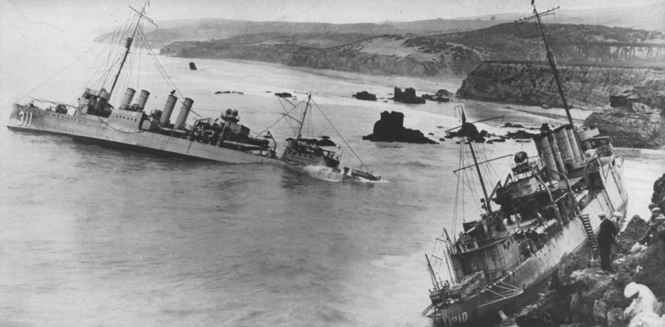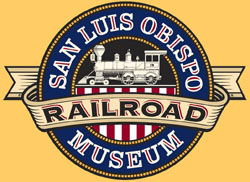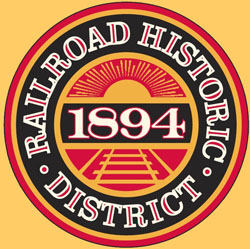

Southern Pacific Heroes at Honda Point
Return to QR Index
On the night of September 8, 1923, seven Navy destroyers, while traveling at 20 knots (37 km/h), ran aground at Honda Point, a few miles from the northern side of the Santa Barbara Channel off Point Arguello on the coast in Santa Barbara County, California. Two other ships grounded, but were able to maneuver free of the rocks. Twenty-three sailors died in the disaster. Below is an article about SP's role in aiding the Navy. Immediately below are two links for additional information:
Honda Disaster: Portraits of Tragedy and Courage - a video created by the Santa Barbara Maritime Museum
Further information about the Destroyers of Honda Point
Article in the Southern Pacific Bulletin of October 23, 1929
Southern Pacific men and women will be interested to know that their comrades on the Coast Division did splendid work in saving lives and giving general relief when seven destroyers of the United States Navy were wrecked on the evening of September 8 on the jagged rocks off Honda California, 63 miles north of Santa Barbara.
Twenty-three lives were lost in the wrecks and 19 men were injured. The timely assistance of Southern Pacific men undoubtedly prevented a greater death toll.
One woman, Mrs. C. L. Atkins, wife of the third trick operator at Surf will be remembered for many years by the Navy men for her fine work in caring for the survivors, making them comfortable, giving them coffee, and doing other acts of kindness. Mrs. Atkins mothered the boys for nearly 24hours without a rest.
The destroyers, parts of a flotilla speeding south to San Diego, the destroyer base, were off their course and crashed head-on into the rocks, one after another piling up before warning by the leaders could be given.
There was a heavy fog all along the coast at the time. The destroyers wrecked were the Delphy, Young, S. P. Lee, Nicholas, Woodbury, Chauncy and Fuller. The destroyer squadron was under the command of Captain Edward H. Watson.
The destroyers were wrecked at a point about a quarter of a mile from the Southern Pacific line and opposite the Honda section house. At 8:46 PM on the evening of September eight, John Giorvas, section foreman at Honda, heard a crash, and minutes later, heard another. He ran to the second story of his home and looking out of the window and saw a light near the shore.
Taking his 16 man, he went to the beach and there saw a destroyer, later found to be the Chauncy, on the rocks. The shouts of the crew could be heard but no one could be seen. Giorvas ran back to the section house and telephoned to the operator at Surf, reporting the wreck. Returning to the beach, he found that two more vessels were on the rocks and a little later discovered two more. It was not until towards morning that it was found that seven ships all told had been wrecked.
Giorvas kept the operator at Surf informed of developments and acted quickly to get men from the destroyers ashore. In the meantime, the information had been conveyed to trainmaster T. G. Foley at San Luis Obispo who immediately made arrangements for the sending of doctors, surgical supplies, food, blankets, clothing, etc. to the scene of the wreck. He instructed the steam shovel gang under Foreman Tobin and the fence gang under Foreman Motis to proceed at once to Honda and render whatever assistance they could. Foley loaded the supplies and stretchers on the baggage car of the southbound Lark and went himself to Honda.
Section foreman Giorvas, after reporting the wreck, threw a rope to the Delphy, which was the closest ship, and the crew connected a heavy line which was pulled ashore. The line was lashed fast and some of the crew then started ashore.
While Mr. Foley was making necessary arrangements at San Luis Obispo, operator W. Pittman at Surf had notified two doctors who were brought to Honda in a section motor car by W. J. Maes, General Foreman, who had been notified by Giorvas. Maes also brought rope, pulleys and tools. Signal maintainer, Ace Reed, followed in his motor. These men with the steam shovel and fence gangs worked with might and main to get the men ashore from the wrecked ships, giving them first aid and building fires to keep them warm.
Foreman Tobin's knowledge of the handling of rope and tackle was especially valuable. In rescuing some of the men washed off the ships, Reed and Tobin plunged into the water to reach them. A high sea was running at the time, making rescue work difficult. As injured men were landed, they were taken to the section house. Fourteen were sent to Santa Barbara on the Sunset Limited that morning.
Lineman Maxwell, Dispatcher Watts, C. Benoit, Secretary to Superintendent F. M. Worthington of the Coast Division, and Operator Pittman came over from Surf. They carried telegraph material from Honda to the section house and opened telegraphic communication.
Trainmaster Foley, on arriving at Honda, reported to Captain Watson, turning over the supplies and offering every assistance. With the arrival of Lineman Pierce, wires were cut in both upstairs and downstairs in the section house for the use of Western Union operators who arrived later in the day.
Owing to the fog conditions, communication was very difficult and during the early morning hours, Southern Pacific wires were the only means of communication from the wreck to the outside world. The telegraph department men did fine work in getting messages through. Operator Pittman at Surf is given special commendation by Trainmaster Foley for the efforts he made to relay information through San Luis Obispo from Honda before they were able to get the telegraph wires open. Extra telegrapher J. M. Brom did good work at Honda.
At San Francisco, A. Keller, Night Chief Dispatcher, was kept busy trying to maintain communication with the South, attending to his regular duties, getting messages to company officials, etc. He did good work, in spite of difficulties in notifying the Navy Yard officers at Mare Island, the Merchants Exchange at San Francisco and other people interested. It was at first thought that the initial reports referred to the wreck of the "Cuba," a merchant ship which had been wrecked farther down the coast.
Trainmaster Foley arranged for a special train to take the crews of the destroyers to San Diego, and with the Red Cross at Santa Barbara, for the feeding of the men on their arrival at that point. The train ran through to San Diego, from Los Angeles over the Santa Fe, without change of equipment. The cars in the train were all well heated on their arrival at Honda so that the men were made comfortable after the long exposure.
Forty-three Southern Pacific employees all told, gathered at the scene of the wreck and worked without thought of their own fatigue, and doing whatever they could to assist the Navy men.
And ranking high in the list of those who did much in this work must be mentioned again Mrs. Atkins, or "Ma Atkins" as the sailors called her, with her coffee, her help in dressing wounds and her general willingness to do anything that would make the "boys" comfortable.
Return to QR Index

